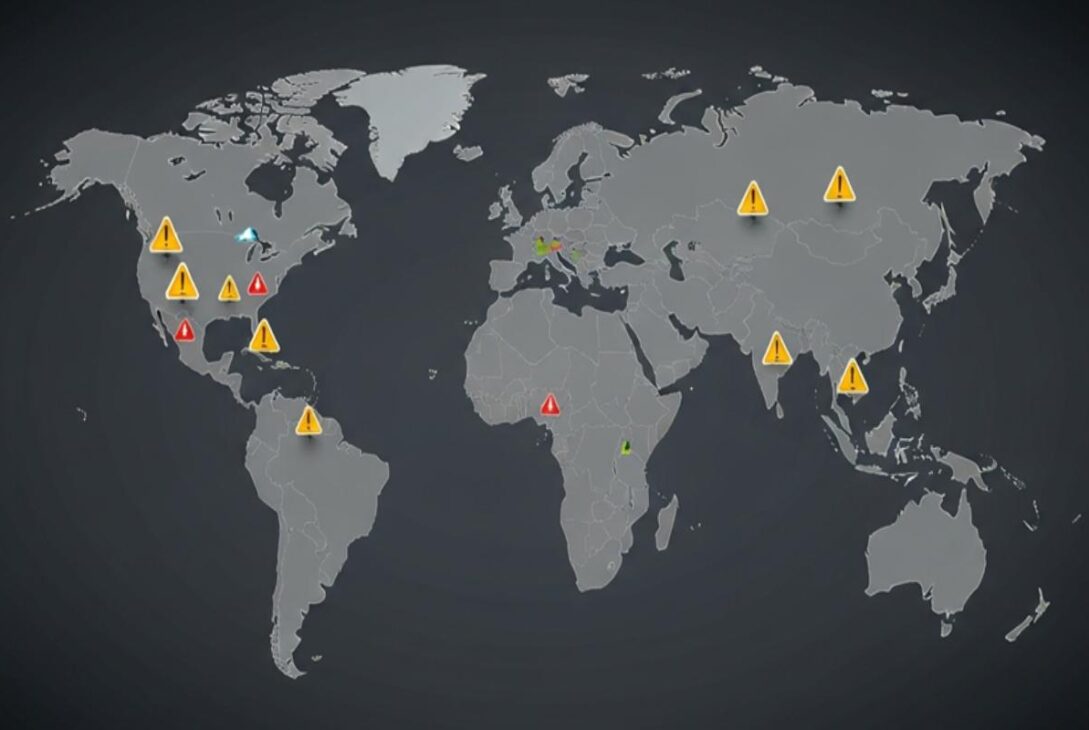Planning a trip is exciting, but staying safe is the most important part of any journey. Did you know the U.S. State Department provides detailed guidance to help you do just that? Through official travel advisories, the government issues an alert to inform you about potential risks in destinations around the world. Understanding these warnings is key to making smart decisions for your travels, whether you’re heading out for vacation or business. This guide will help you understand these advisories and where to find them.
Understanding Travel Warnings and Their Importance
Travel warnings are official notices issued by government bodies, primarily the U.S. Department of State, to inform citizens of potential dangers in other countries. These travel advisories are based on a wide range of factors, including crime, civil unrest, health risks, and political instability.
Their primary importance lies in helping you assess risks and take the right precautions. By heeding these warnings, you can make informed choices that directly impact your security and safety, potentially avoiding dangerous situations. Let’s look at why these alerts are so vital and the different forms they can take.
The Purpose of Travel Alerts for Tourists and Business Travelers
For tourists planning a getaway, travel alerts are an essential safety tool. The State Department warns that violent crime can occur even in popular tourist destinations. For example, recent advisories have urged Americans to exercise increased caution in Mexico and to reconsider travel to Jamaica due to crime and unreliable medical services. These warnings help tourists avoid specific dangers and take necessary precautions.
Business travelers also rely heavily on these alerts to navigate international landscapes safely. A “Do Not Travel” advisory for a country like Venezuela, where the State Department has no operating embassy, signals severe risks that could disrupt business operations and endanger employees. Companies use this information to create safe travel policies for their staff.
Ultimately, whether you are traveling for leisure or work, the purpose of these advisories is to empower you with knowledge. They provide the context needed to understand the risks, take appropriate precautions, and decide if a trip is worth the potential danger. They are a fundamental resource for all international travelers.
Different Types of Travel Warnings Issued by Authorities
The U.S. Department of State uses a straightforward, four-level system for its international travel advisories. This tiered approach helps you quickly understand the level of risk associated with a particular destination, making it easier to gauge the seriousness of an alert.
Each level corresponds to a specific recommendation, giving you clear, actionable advice. The system is designed to be easy to understand at a glance. The levels are:
- Level 1: Exercise Normal Precautions: The lowest advisory level for risks.
- Level 2: Exercise Increased Caution: Be aware of heightened risks to safety.
- Level 3: Reconsider Travel: Avoid travel due to serious risks.
- Level 4: Do Not Travel: The highest level, indicating life-threatening risks.
These travel advisories cover a wide spectrum of issues. While many focus on crime or political turmoil, others are health-related. For instance, the CDC issued an alert warning travelers to Mexico of potential exposure to Rocky Mountain spotted fever, highlighting that safety concerns are not limited to security threats.
How Travel Warnings Are Issued and Updated
Official travel warnings for Americans are issued by the U.S. Department of State. This government body is the most reliable source for information on international travel safety. As reported by news outlets like CBS, these advisories are not static; they are regularly updated or reissued to reflect changing conditions on the ground.
The process is dynamic, with updates happening as new information becomes available. An advisory could be changed on a Monday following a weekend incident or updated on a Tuesday as a situation evolves. This constant monitoring ensures you have the most current information. But who makes these decisions, and how is the information reviewed?
Who Sets Official Travel Advisories?
The United States Department of State is the primary authority that sets official travel advisories for American citizens. This agency is tasked with analyzing global risks and providing guidance to help keep travelers safe when they are abroad. Their website is the definitive source for the latest information.
The State Department’s advisories are informed by a wealth of intelligence gathered from U.S. embassies and consulates around the world. For example, when issuing a warning for Venezuela, the Department of State specifically noted its lack of an operating embassy there, emphasizing the “severe risks.” This on-the-ground presence (or lack thereof) is critical for assessing security conditions.
While the State Department is the main source for these advisories, other U.S. government agencies, like the Centers for Disease Control and Prevention (CDC), issue health-specific alerts. News organizations such as CBS News play a key role in broadcasting these updates to the public, ensuring the information reaches a broad audience.
The Process of Reviewing and Updating Warnings
The review process for travel warnings is continuous. The State Department doesn’t just set an advisory and forget it; officials constantly monitor global events to determine if an alert needs to be raised, lowered, or removed. A sudden spike in crime or political unrest can trigger an immediate update, whether on a Monday, Tuesday, or any other day of the week.
This system ensures that the advisories reflect the most current situation in a country. A destination that was considered safe last year might face new challenges this year, prompting a change in its advisory level. The process is both proactive, with regular reviews, and reactive, responding swiftly to new developments to keep travelers informed.
The four-level alert system provides a clear framework for these updates, helping you understand the severity of the risks at a glance.
| Advisory Level | Meaning |
| Level 1: Exercise Normal Precautions | This is the lowest level, yet it reminds you to be aware of your surroundings. |
| Level 2: Exercise Increased Caution | This level indicates heightened risks to safety and security. |
| Level 3: Reconsider Travel | This suggests you should avoid travel due to serious risks. |
| Level 4: Do Not Travel | This is the highest level, signaling a greater likelihood of life-threatening risks. |
Key Destinations with Current Travel Alerts
Many countries around the world are currently under U.S. travel advisories, including some very popular vacation spots. For example, the State Department has issued warnings for Mexico, Jamaica, and the Bahamas due to concerns about violent crime. These alerts advise travelers to be extra vigilant.
Other advisories are far more severe. Countries like Russia are under a “Do Not Travel” warning due to the high risk of wrongful detention of U.S. citizens. These key alerts highlight a range of dangers that travelers may face. Let’s explore some of these destinations in more detail.
Countries Affected by Security and Safety Warnings
The State Department has placed several countries under its highest “Level 4: Do Not Travel” advisory due to severe security risks. This list includes Russia, Venezuela, Iran, and North Korea, where the potential for wrongful detention and arbitrary enforcement of local laws is a major concern for American citizens.
Beyond these high-risk nations, many popular tourist destinations also face security and safety warnings. The U.S. Mission to Mexico warned that “crime, including violent crime, can occur anywhere in Mexico.” Similarly, Jamaica and the Bahamas have advisories related to a rise in homicides, prompting the State Department to urge caution.
These warnings also cover less obvious dangers. For instance, an American was recently sentenced in Turks and Caicos for having ammunition in their luggage, highlighting how local laws can pose a significant risk. These advisories help you prepare for all types of security threats, from violent crime to the risk of detention.
Destinations Facing Health-Related Travel Advisories
Travel safety isn’t just about avoiding crime; it also involves being aware of health-related risks. The Department of State and the CDC issue travel advisories that specifically address medical concerns, which can be just as disruptive as security threats. These alerts provide crucial information on disease outbreaks and healthcare limitations.
Unlike last year, when concerns might have been different, recent advisories have highlighted specific regional health issues. A notable example is the CDC’s warning to travelers in Mexico about Rocky Mountain spotted fever, a tick-borne illness that can cause fever, headache, and rash. This shows how advisories can be very specific to a particular health threat.
These health-related warnings cover a range of issues you should be aware of before you travel. Key examples from recent advisories include:
- Disease Outbreaks: The CDC issued an alert for Rocky Mountain spotted fever in certain parts of Mexico.
- Unreliable Medical Services: This was cited by the Department of State as a reason for its “Reconsider Travel” advisory for Jamaica.
- Access to Care: Warnings often include information about the quality and availability of local medical facilities, which can be critical in an emergency.
Conclusion
In conclusion, staying informed about travel warnings is crucial for ensuring your safety and well-being while traveling. Understanding the different types of travel alerts and how they are issued can help you make informed decisions about your trips. By keeping abreast of the current conditions in key destinations, you can better prepare for potential risks and challenges. Remember, being proactive about travel advisories can enhance your travel experience and peace of mind. If you have any questions or need assistance navigating travel warnings, don’t hesitate to reach out to us for help. Safe travels!
Frequently Asked Questions
What should I do if a travel warning is issued for my destination?
If an alert is issued, carefully read the official travel advisories on the Department of State website. Follow all recommended precautions, which may include reconsidering your trip. For updates, enroll in the Smart Traveler Enrollment Program (STEP) to receive alerts via email directly from the U.S. embassy in your destination.
How can travel warnings affect my health insurance or travel plans?
Traveling to a destination against official Department of State travel advisories, especially a “Level 4: Do Not Travel” warning, may void your travel or health insurance policy. It is crucial for Americans to review their insurance coverage details before traveling, as policies on this can differ from those in place last year.
Where can I find the most reliable and up-to-date travel warnings?
The most reliable source for an alert is the official U.S. Department of State website. For direct updates, you can sign up for their STEP program for email notifications. Additionally, major news outlets like CBS News regularly report on new and updated travel advisories, helping to keep the public informed.



